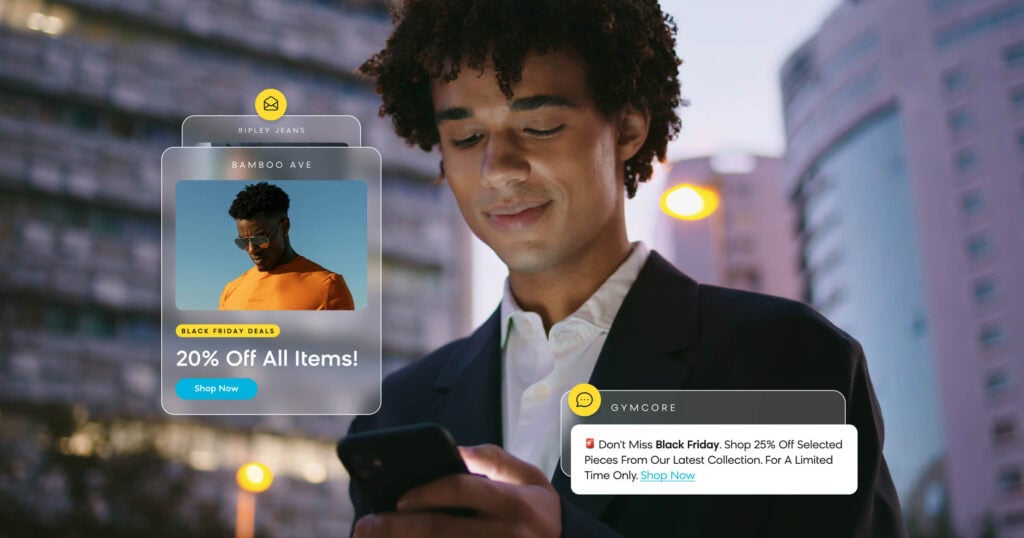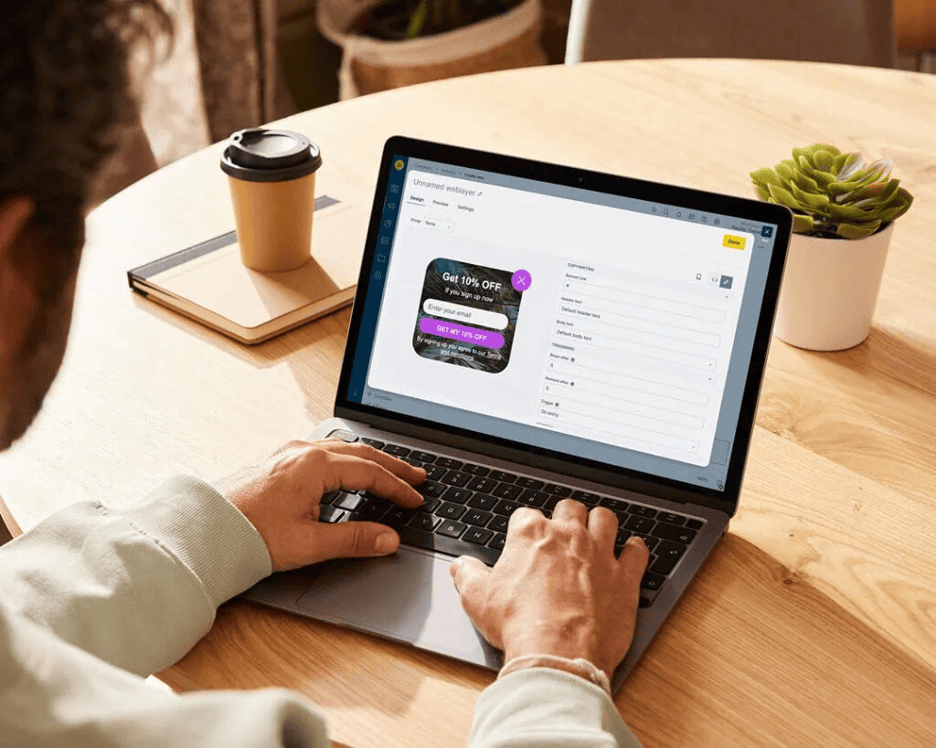Introduction
In the world of email marketing, customers have come to expect personalized emails — which means your company needs to adopt a personalized email marketing strategy to accommodate these customers. Ecommerce personalization has proven to be a powerful tool for increasing customer engagement, improving open rates, and driving conversions. But what exactly is personalized email marketing, and how can it benefit your email marketing campaigns?
Personalized email marketing is the practice of creating targeted emails and customizing them with unique content that is relevant to each individual recipient. This data-driven approach uses customer data to create personalized subject lines, content, and calls-to-action that resonate with subscribers. By using email personalization strategies, businesses can increase the relevance and effectiveness of their email marketing strategy.
At the heart of personalized email marketing is the use of customer data, which provides valuable insights into the interests, preferences, and behavior of your target audience. By collecting and analyzing this data, your marketing team can craft personalized content and send targeted emails that are tailored to the specific needs of your subscribers.
Personalized subject lines are one of the most effective ways to increase email open rates. By using the recipient’s name, location, or previous purchase history in the subject line, you can create a sense of familiarity and relevance that entices the recipient to click and open the email.
There are many tools available to help with email personalization, including email marketing software and platforms. These tools can help you automate the process of personalizing emails, allowing you to create and send targeted campaigns at scale. By personalizing emails for both new and existing customers, you can create a more engaging and effective email marketing strategy that delivers better results for your business.
Keep reading to dive deeper into the world of email marketing personalization and explore the various personalization strategies that can help increase customer engagement and drive conversions. We’ll also discuss how to use customer data to create more effective marketing campaigns and provide tips and best practices for personalizing emails that resonate with your target audience. By the end of this post, you’ll have a better understanding of how personalized email marketing can benefit your business and how to integrate it into your email marketing strategy.
If you’re actively trying to improve your personalized email marketing campaigns or in the marketing for a new email service provider (ESP), then you’ll know that there are thousands of bits of information just one Google search away.
But it isn’t always easy discerning which tidbits of that information are true, somewhat true, or just flat out wrong in relation to your specific needs. Sorting through buzzwords, sifting through report after report, and even sitting through lengthy sales calls can leave your head spinning, and you may not always know how to separate what information is true for your company versus what’s not.
With that in mind, welcome to email marketing mythbusters — here to help you determine what information is trustworthy as your company evaluates your next steps with email marketing.
Personalizing your email marketing campaigns is a proven tactic for success — by using the data you’ve collected, you can create a custom experience that is unique for every individual and meets them where they are on the customer journey with your brand.
And putting a personalized touch on your email marketing program is more important than ever as customers increasingly desire personalized experiences from brands.
But it isn’t always so easy, is it? Unfortunately, there’s no magic or secret formula for inbox placement that gives you the exact right combination of subject line, spam trap avoidance, timing, and more.
Three data points from McKinsey also tell that story well:
76% of consumers become frustrated when they don’t get a personalized experience
78% of consumers are more likely to make a repeat purchase with a brand that personalized their online shopping experience
76% of consumers are more likely to consider purchasing from companies that use ecommerce personalization strategies
Statistics like these can be responsible for planting myths in our minds about email marketing — myths related to data, ESPs, and all sorts of other aspects of email. Let’s tackle those myths together.

Myth #1: We Don’t Have Enough Data to Create Personalized Email Marketing Campaigns
The classic “we don’t have enough data” myth. We’ve all heard it before. Everybody knows a marketer who works at a company that thinks it hasn’t collected enough data to personalize customer experiences at scale.
Perhaps said company simply hasn’t collected the right type of data, or the data it has collected is unsanitized or inaccurate. But it is largely a myth that companies do not have enough data to create personalized email marketing campaigns. And this myth comes from not truly understanding the definition of ecommerce personalization and what it means for digital commerce companies — here’s how we at Bloomreach define it:
Ecommerce personalization is the practice of using commerce data responsibly to get to know, guide, and impress your customers with experiences that are so relevant and contextual, they feel like magic.
Ecommerce personalization spans cross-channel, on-site, and in-app. It encompasses anonymous and known customers, and includes personalized messages, content, site layouts, products, and much – more.
It is driven by real-time first-party data. This results in measurable journeys that engage and lead customers through brand awareness to product discovery to repeat purchases.
So what does that mean for companies who think they haven’t collected enough customer data to personalize their customers’ experiences? Really, it means that ecommerce personalization is so much more than just putting “Hi <first name>” on your campaigns or sending emails to customers on their birthdays.
In today’s market, companies can hyper-personalize customer experiences based on user actions. Campaigns can be personalized based on what your customers have browsed, searched for, added to their carts, and/or purchased, provided that they have given consent. This previous history can better inform your company’s next actions with customers.
Benefit Cosmetics is the number one prestige makeup brand in the UK and number one brow brand worldwide, and is synonymous with fun, instant beauty solutions. When it was looking for an omnichannel campaign centered around personalized email marketing to launch a new line of blushes, it used Bloomreach Engagement to make a big splash.
The campaign was split into three sections: pre-launch, launch, and post-launch. Each section had different objectives (driving launch awareness, recruiting new customers, supporting sell-through) and communications were sent using Bloomreach Engagement to help accomplish these goals.
Benefit heavily segmented its customer audiences, splitting them up into previous buyers, VIPs, and customers who opted in for the waitlist (in exchange for an exclusive promotional gift with purchase offer and access to the new launch before other customers). Four pre-launch emails were sent to set the scene for the campaign, drive excitement for the new launch, and push people to sign up for the waitlist.
The customers who signed up for the waitlist then entered a short countdown workflow. Emails sent to those customers had an incredible 10.10% average click-through rate overall — a direct result of Benefit’s efforts and the real-time segmentation capabilities of Bloomreach Engagement.
When the campaign launched, Benefit’s creative marketing mindset and incredible products, combined with Bloomreach Engagement’s customer journey orchestration, proved to be the backbone of the campaign. Click-through rates on Blush Launch emails were 50% higher than the average Benefit campaign this year.
Benefit’s marketers were able to understand their customers’ journeys through Bloomreach Engagement and use those insights to inform and execute the next action of their campaign. They also reported on the end-to-end success of their launch across channels using the custom reporting and analytics tools within the platform rather than relying on complex business analytics tools or Microsoft Excel.
Ultimately, Benefit was able to attribute leads and orders to the right channels thanks to an all-in-one platform, and could make an educated decision on where to invest to optimize future campaigns.
Myth #2: It’s Impossible to Win With Personalization Because of Data Sensitivity
Along those same lines, a similar myth has become all too common amongst marketers who deal with customer data on a daily basis.
While respecting customer privacy is of the utmost importance, it is a myth that it’s impossible to win with personalization because of the sensitive nature of your customer data. While you may face extra challenges because the nature of your industry requires it, there are always ways to personalize the customer experience without exploiting sensitive data.
A proper consent management process is the first thing needed to work around any potential sensitive data issues. Consent management is a system or process for allowing customers to determine what personal data they are willing to share with a business. If your ESP or multichannel marketing platform does not foster an easy consent management process for both your customers and practitioners, you are taking a very big risk in today’s privacy-centric market.
Consent management has become so important worldwide because of the lawful requirement for websites to obtain user consent for collecting data through cookies while browsing. Businesses are now responsible for collecting and managing customer consent. Properly managing customer consent will outline exactly what collected customer data you can use for personalized email marketing campaigns and what data your customers do not consent to your company using.
Next, consider zero-party data. If the customer data your company has collected is sensitive in nature and therefore difficult to use to personalize customer experiences, why not try to collect additional data from your customers to support your marketing efforts? That’s where zero-party data comes in.
Zero-party data is data that a customer intentionally and proactively shares with a brand. It can include preference center data, purchase intentions, personal contexts, and how an individual wants to be recognized by the brand. And if your brand needs to be careful in circumventing sensitive customer data, it’s the perfect way to compliantly gain access to more customer data — just ask baby-walz.
The German retailer specializes in everything for young children and nursing mothers, selling a range of products from clothing to baby furniture. And as you can imagine, the company deals with sensitive customer data due to the nature of its business and customers.
After the introduction of the General Data Protection Regulation (GDPR) in the European Union, it became critically important for digital commerce companies to carefully collect the consent of their customers. baby-walz wanted to ensure that it stayed compliant with GDPR and respected the privacy of its customers, all while still offering the same quality personalized email marketing campaigns that its customers had come to expect.
To do this, baby-walz set up a double opt-in scenario within Bloomreach Engagement. As a part of the opt-in process, the company collected key bits of zero-party data about their customers, including their preferences for marketing materials and information about the child on the way.
Thanks to the key information being collected in the double opt-in scenario, baby-walz personalized the expectant mothers’ customer experience with its brand during their pregnancies. The data gathered helped identify which stage of pregnancy mothers were in and baby-walz could send emails accordingly that were tailored to each stage.
And customers clearly saw the value of these personalized emails, with open rates of 53.8% for this campaign. The additional collected zero-party data supported an incredible campaign for baby-walz, proving that the proper consent management and zero-party data collection can trump any sensitive data issues your company may face.
Myth #3: I Can’t Improve My Personalized Email Marketing Because I Can’t Change My ESP
With email campaigns, it can be frustrating to feel stuck or trapped. Stuck in your current way of doing things, trapped with your current ESP, or just generally locked in to your email marketing processes with no hope of making any positive changes.
Good news — it’s a myth that you can’t improve your personalized email marketing because you’re locked in and can’t change your email service provider. It’s also false that the implementation process and migrating of templates, workflows, and data will take too long and be too much of a lift to your team to justify the changes.
Switching ESPs can improve service, optimize personalized email marketing campaigns, and increase ROI on email marketing. Believing the above myth leads companies to settle for their current ESP — which can lead to a less-than-stellar email marketing program for your brand.
While we don’t want to paint the picture that migrating ESPs will be a walk in the park, it can be more than worth it if your company finds an ESP that it believes can improve its email deliverability and help you reach your email marketing KPIs. It’s crucial to consider the long-term benefits of such a move — if it’ll result in more email marketing revenue and more ease of use for your practitioners, it should be an easy choice to make.
But when you make that choice, make it with a plan in place. MarTech offered five tips for a successful migration to make the process less complicated:
- Develop a custom migration plan
- Have your C-level executives endorse your migration plan
- Establish priority for the migration work
- Establish your own migration priorities and get help
- Audit your existing programs
Finnish railway company VR is the perfect example of a company that successfully changed ESPs in order to optimize the customer experience. It opened up a world of personalized email marketing possibilities for the company.
Rather than sending generic messages to its entire customer base as it had previously done, VR can now send personalized email campaigns to segmented groups of customers that deliver a relevant message and inspire action. This contributes to VR’s growth by personalizing communications that encourage customers to travel more often or add on to their travel experiences.
By switching its email marketing to Bloomreach Engagement, employees with a less technical background can utilize collected customer data to generate these personalized campaigns. This lets marketers easily form target groups or evaluate data in different customer segments to determine what types of communications should be sent to which customers. This has greatly increased efficiency for VR since replacing its legacy ESP, and has driven a 30% increase in revenue per customer who receives email communications.
VR’s story is proof that you are never locked into an ESP. Don’t believe this myth — your personalized email marketing will suffer if you do.
Myth #4: Great Email Marketing Is All About Great Design
How your emails look when they hit your customers’ inboxes is part of the equation that adds up to email marketing success. Bad creative, poor copy, and broken links will absolutely impact your email marketing engagement metrics.
But it is absolutely a myth that great email marketing stems completely from great email design. It is one of the most common misconceptions in the marketing world that ESPs that are design-forward are best. If this were true, plain-text emails would not perform as well as they do.
In truth, what your ESP can do with your collected customer data is the major differentiator in today’s market. It elevates your email marketing so you can run truly customer-centric marketing campaigns, provided your brand is sending out emails that meet your customers where they are on their journeys.
And yes, every company has data. But does every company have a single source of truth for that data? Another consideration — if customers asked you to delete their personal data, would you be able to do that in one place?
If you can’t, then getting access to a single customer view will make a massive difference and allow for a big upgrade to both your email marketing program and your multichannel marketing efforts. Having a powerful customer data platform would buoy those efforts even further.
What specifically can the right CDP do?
Remove data silos and unify customer data into a single marketing view. This data can then be used to launch personalized marketing campaigns in real time through built-in channels.
Elevate your email marketing program with advanced targeting and AI-powered personalization. Always target the right segments of your audience and deliver your emails at the right time.
Pick the channels that best fit your brand to deliver connected commerce experiences to your customers. Having a CDP power all of your multichannel marketing under one roof, including your email, SMS, web/mobile push, in-app messaging, and more allows your company to streamline its marketing efforts.
But this doesn’t work with just any CDP. The CDP must be made for marketing and give you the ability to drive all of your campaigns from one place, all while being powered by compliantly collected customer data. It also must facilitate the collection and effective usage of first-party data in those campaigns.
If you did answer yes to the original data minimization question, your company likely already has a single source of truth of data. This could be a data warehouse, data lake, or even a CDP. These tools serve as ways to store your data centrally in a cost-effective way. A CDP is essential for data cleansing, unification, and identity resolution.
But how much of that data can you, the person working with your company’s marketing technology on a daily basis, use to independently execute a campaign? How much effort does it take to understand how your campaigns are impacting the user journey? If email marketing is going to be elevated to be the strategic tool your company needs, the answers to those questions have to be considered and the insights have to be used to drive revenue, engagement, and retention in a time-efficient manner.
Email solutions that are rooted in data and analytics understand that email marketing is not just about great design. Email personalization cannot be effective without data — not only for segmenting and targeting audiences, but also knowing how to adjust, tweak, and change your campaigns based on your customers’ responses.
These solutions come with everything you need to create beautifully designed emails, as well — drag-and-drop editors, reusable snippets, HTML blocks, and more. But there’s so much more to email marketing than just great design, thus disproving this myth.
Myth #5: The More Emails, the Better
As technology continues to connect us all online, we see more messaging that promotes consumption of goods and the constant need for bigger and better things.
But does the “bigger (and more) is better” notion always ring true in email marketing? Definitely not.
Many practitioners are pushed to increase sales revenue by increasing campaign output and the number of promotions they offer via email. While there’s often a short-term gain associated with this, that gain can hurt long-term growth in the form of diminishing list sizes, lower email deliverability rates and bad sender reputation, consumer conditioning to sales and discounts, and inefficient marketing spend.
Consider your customer data when it comes to your ESP or CDP (or however you send personalized emails en masse). A “less is more” mindset and strategy can really pay off in leading customers along their journey with your brand.
How can sending less emails result in more revenue? Logically, it doesn’t equate. But the stats show that it does. Sending too many emails to certain customers can make them unsubscribe, undermine your domain reputation, and ultimately impair their trust in your brand.
Success starts with…
Proper deliverability guidance
An IP warm-up
Built in consent management categories to customize your preference center
After that, you should apply a frequency policy on emails that combines expert-defined rules with artificial intelligence to dynamically manage email frequency based on customer engagement.
What exactly does that mean? It means managing your email sends to specific segments of your customer base so that they don’t get too many or too few communications from your brand. You should be able to set generic frequency rules for your entire audience or intelligently limit the number of campaigns by dynamically adapting to each individual customer’s level of interaction and engagement with your brand.
You want informed customers, not overwhelmed ones. Informed customers make educated decisions about what to purchase from your brand and will become loyal customers. Overwhelmed customers unsubscribe from email communications and send your emails to the spam folder.
The reduction of the frequency of emails is a proven tactic for re-engaging a less committed audience. Don’t fall into the trap of thinking more is always better with your marketing. Taking a step back and being more strategic with your emails and other personalized communications can result in better metrics down the line. “More” and “bigger” are not always better with marketing automation campaigns.
The Truth Is Out There (But So Are Lies)
Email personalization tactics have become increasingly important for email marketers looking to improve the effectiveness of their email marketing campaigns. By using a combination of dynamic content, triggered emails, and personalized messages, businesses can create more relevant and engaging email campaigns that resonate with their audience.
To personalize your emails effectively, you need to use as much data as possible. Segment your audience using email personalization techniques and use personalized subject lines and relevant messages to increase click-through rates. When creating your email campaigns, it’s essential to personalize your emails to engage readers. Re-engage your audience with personalized communication that delivers the most relevant message for each recipient.
Email personalization can be accomplished using marketing automation tools, allowing marketers to send targeted emails with relevant information and personalized images. It provides an opportunity for businesses to start personalizing emails at a personal level that online shopping carts and other behavioral data miss. By creating targeted and personalized email campaigns, you can open up a personal touch that can create a sense of urgency and engagement for your audience.
Email marketers need to follow up their email campaigns with triggered emails that encourage meaningful relationships and repeat business, such as welcome emails or abandoned cart emails. Businesses of all shapes and sizes can use email personalization to create a more effective marketing strategy that delivers a personal touch at scale.
Furthermore, email personalization in marketing campaigns should be an integral part of every company’s online marketing strategy. When done correctly, personalization elements such as a personalized subject, email content, and personalized images can deliver great results, establish a personal relationship between the business and customer, and improve the company’s position. Personalized and timely emails help to create a connection between the business and the recipient, and personalized business emails lead to more meaningful relationships and repeat business.
With our aforementioned myths busted, where does that leave your company in its search for the right solution to drive email marketing?
We hope we’ve helped you better understand the truths and myths within the digital commerce market. There are a lot of marketing myths that keep circulating, but the truth is out there, and we’re happy to help you find it.
If your current ESP is causing your company to have a less-than-stellar deliverability rate, that is massively affecting your email ROI and the revenue you’re generating from email marketing. Learn just how much revenue your company is leaving on the table and how exactly you can fix that so you can optimize your profits from email with our email deliverability calculator. It’s a great tool for your company to learn more about how to increase your email marketing revenue.
With email potentially driving high ROI, maximizing deliverability is critical to revenue growth.
Take the assessment to see how much money you could be leaving on the table.






